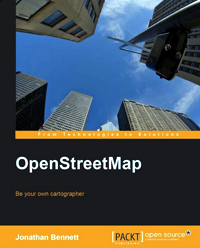
 OpenStreetMap is a global mapping project that is built through the contributions, efforts and experiences of individuals in communities. Frustrated with a myriad of legal complications for using traditional maps, the OpenStreetMap community consists of individual and group efforts that contribute vectors for streets and places, resulting in cartographic products that anyone can use and build upon. This book describes how that process is achieved – from using GPS to collecting data to use in geographic information systems (GIS) and much more…
OpenStreetMap is a global mapping project that is built through the contributions, efforts and experiences of individuals in communities. Frustrated with a myriad of legal complications for using traditional maps, the OpenStreetMap community consists of individual and group efforts that contribute vectors for streets and places, resulting in cartographic products that anyone can use and build upon. This book describes how that process is achieved – from using GPS to collecting data to use in geographic information systems (GIS) and much more…
OpenStreetMap – Be Your Cartographer
by
Jonathan Bennett
ISBN: 9781847197504 2010 237 pages
Review by Jeff Thurston
Authored by Jonathan Bennett this book neatly summarizes the current state of the OpenStreetMap effort, a community based international mapping effort that engages individuals and groups toward building their own cartographic product, for free use.
The OpenStreetMap project was initiated by Steve Coast, who at the time of this review has just been hired by Microsoft’s Bing Maps to become Principal Architect. When OpenStreetMap began, the idea was to involve the public in the building of local maps that could be freely used and developed upon.
Toward that end, small groups of people gather locally, and set out to map their local communities using global positioning systems (GPS) technologies. Rather than following strict approaches used in mapping agencies and the like, OpenStreetMap flourishes due to the fact people know their own neighborhoods well – they map with experience. Individually these people are called ‘mappers’ and collectively, when operating, the approach is termed ‘crowdsourcing’.
Bennett explains what OpenStreetMap is, how it differs from other sources, how people can capture and edit the information and how they can ultimately develop other applications based on the information. This information then resides in the OpenStreetMap Foundation (OSMF). The ability of large numbers of people to quickly organise, plan and gather spatial data used for building OpenStreetMap is one of it’s strengths and the author explains how this process happens.
The data is held on servers through OSMF and operated by openstreetmap.org – where web mapping results can be uploaded to and downloaded from. The Wiki, email lists and communication strategies for OpenStreetMap are explained.
Since many people may not have gathered GPS data personally, the book explains what GPS is in an easy-to-understand manner, how to set up a GPS receiver and how to go about collecting information in the community. It also explains how to check these ‘traces’ prior to uploading them to the server for use by others. Since photos and sounds can be integrated with GPS data, the author also includes instructions for performing these tasks.
Bennett explains how features and other geographical information is actually gathered. OpenStreetMap includes an application program interface based on XML and care has been taken in this book to explain it in minimal terms without complexity – ‘the simplest thing that will work’. He also explains the issue of ‘tags’ – used to identify features that are recorded. While mappers can provide whatever tags they wish, it can often speed up use and help others by reviewing the openstreetmap.org website to see how others are tagging similar features.
Potlatch – the web based editor, JOSM – a Java-based editor and Merkaartor – desktop editing application are also described. The author does a good job describing how all the editing functions within the web interface work, and pictures are included. The issue of overlapping features is also discussed.
I have to admit that I had not investigated OpenStreetMap closely until this review and was interested to see the photo export function within the interface. In fact, one of the options also includes the ability to export your map in scaleable vector graphics (SVG) format, something I like to use often. If you want to work with KOSMOS, the Windows stand-alone editor, it can import files such as OpenStreetMap data, GPX format, contours and existing web maps. Bennett explains how all these work. Inkscape is my SVG stand-alone editing package and it was interesting to see it recommended for use with OpenStreetMap.
If one wants to dump the entire database from the project, a Planet File (entire OSM database) can be downloaded. Finally, OSMOSIS can be used for command line JAVA operation.
In summary, the author explains OpenStreetMap from beginning to end in a complete and easy-to-understand way. I learned quite a few things from this book that I did not know, and in doing so it helped to understand how crowdsourcing could become more useful in GIS applications in ways to enrich and increase the value of current databases.
This book will be very helpful to the many individuals who are interested to become involved in the OpenStreetMap project as ‘mappers’ and for existing GIS users who want to expand and integrate OpenStreetMap into their applications. Alternatively, developers will find this information useful, since it opens the door into the openstreetmap.org servers and data structures, thereby allowing them to start building more interesting applications.